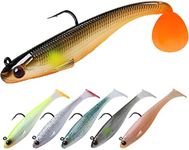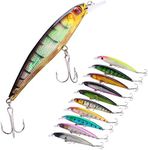Buying Guide for the Best Northern Pike Lures
Choosing the right lure for northern pike fishing can make a big difference in your success and enjoyment. Northern pike are aggressive predators, but their preferences can change based on water conditions, season, and even their mood. When picking a lure, you want to think about how it moves, its size, color, and how deep it goes. Understanding these key features will help you match your lure to the environment and the behavior of the fish, increasing your chances of a great catch.Lure TypeLure type refers to the general style or category of the lure, such as spoons, spinners, crankbaits, jerkbaits, or soft plastics. Each type moves differently in the water and can trigger different responses from pike. Spoons and spinners create a lot of flash and vibration, which can attract pike from a distance, while crankbaits and jerkbaits mimic the movement of injured fish. Soft plastics can be rigged in various ways for a more subtle presentation. To choose the right type, consider the water conditions and how active the pike are—flashy lures for murky water or aggressive fish, and more natural-looking lures for clear water or finicky fish.
Lure SizeLure size is about the length and weight of the lure. Bigger lures are more visible and can attract larger pike, while smaller lures might be better for shy or pressured fish. Generally, northern pike are not shy about attacking large prey, so lures in the 4 to 8-inch range are common. However, in early spring or in heavily fished areas, downsizing to smaller lures can be effective. Match the size of your lure to the size of the pike you expect to catch and the size of the baitfish in the water.
Lure ColorLure color affects how visible and attractive your lure is to pike. Bright colors like chartreuse, orange, or firetiger work well in murky or stained water, while more natural colors like silver, white, or perch patterns are better in clear water. The time of day and weather also play a role—brighter colors for cloudy days or low light, and more subtle colors for sunny, clear conditions. Choose your lure color based on the water clarity and light conditions where you’ll be fishing.
Lure ActionLure action describes how the lure moves in the water. Some lures wobble, dart, or spin, while others glide or sink slowly. The action can trigger a pike’s predatory instincts, especially if it mimics an injured fish. Fast, erratic actions are good for active pike, while slower, more subtle actions can tempt less aggressive fish. Think about how you want to present your lure and how the pike are behaving—if they’re chasing, go for more action; if they’re sluggish, try something slower.
Running DepthRunning depth is how deep the lure goes when you retrieve it. Some lures float on the surface, some run just below, and others dive deep. Pike can be found at different depths depending on the season and water temperature. In spring and fall, they’re often shallow, while in summer they may move deeper. Choose a lure that runs at the depth where the pike are likely to be. If you’re not sure, start with a lure that covers a range of depths or use a sinking lure you can control.
Hook StrengthHook strength refers to how sturdy and sharp the hooks are on your lure. Northern pike have strong jaws and sharp teeth, so you need hooks that won’t bend or break. Look for lures with strong, high-quality treble or single hooks. If you’re fishing in areas with lots of weeds or snags, consider lures with weedless hooks. Always check the hooks before fishing and replace them if they’re dull or damaged to avoid losing a big fish.















